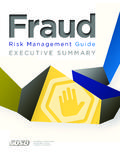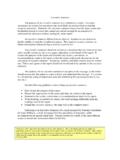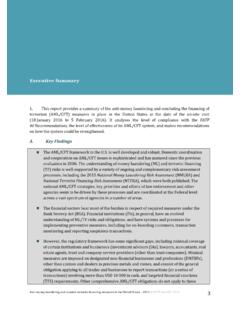Transcription of Executive Summary EXECUTIVE SUMMARY
1 Anti-money laundering and counter-terrorist financing measures in Switzerland 2016 FATF 2016 3 EXECUTIVE SUMMARY EXECUTIVE SUMMARY 1. This report provides a SUMMARY of the Anti-Money Laundering and Countering the Financing of Terrorism (AML/CFT) measures in place in Switzerland as at the date of the on-site visit (25 February 11 March 2016). It analyses the level of compliance with the FATF 40 Recommendations and the level of effectiveness of Switzerland s AML/CFT system, and provides recommendations on how the system could be improved. A. Key Findings Swiss authorities generally have a good understanding of the risks of ML/TF, which was furthered by the first National Risk Assessment (NRA) published in June 2015.
2 In 2013, Switzerland set up an AML/CFT co-ordination and cooperation body to bring AML/CFT strategy and policies in line with changes in identified risks. The Swiss financial system is exposed to a high risk of ML associated with the laundering of assets derived from offences that are mostly committed abroad. Banking, in particular private banking, is the sector most exposed to these risks. A number of important aspects specific to Switzerland, such as the use of cash or legal persons in general, including domiciliary companies, have not yet been analysed in detail with regard to the ML/TF risks to be included in the NRA. The risk of TF is more limited, but outreach is required to raise the awareness of non-profit organisations (NPOs).
3 The Swiss AML/CFT framework has been developed using a risk-based approach and reflects the high risk level associated with the banking sector. In general, Swiss authorities take identified risk into account in their objectives and activities. In general, financial institutions and designated non-financial businesses and professions (DNFBPs) understand the ML/FT risks they face and their associated obligations. Overall, they apply measures commensurate with their risks, although classification of customers into inappropriate risk categories can undermine this approach. The implementation of due diligence measures with existing customers is not always satisfactory, particularly for longstanding customers of banks and asset managers classified as low risk at the beginning of the relationship, and where the source of funds was not always identified in line with current requirements.
4 4 Anti-money laundering and counter-terrorist financing measures in Switzerland 2016 FATF 2016 EXECUTIVE SUMMARY The number of suspicious transaction reports (STR) has been steadily increasing for several years following awareness-raising campaigns for reporting entities led by the Swiss authorities. However, the number remains insufficient, and most of them are produced in response to external information sources, usually when there is a grounded suspicion of ML/TF. FINMA needs to increase supervision and sanctions regarding compliance with the reporting requirement. The approach to AML/CFT supervision in Switzerland generally encourages a continuous monitoring of financial institutions and DNFBPs.
5 The authority of the Swiss Financial Market Supervisory Authority (FINMA) is recognised by self-regulatory bodies (OARs) and the institutions/professionals it supervises directly. While this means that the remedial measures imposed by FINMA are generally complied with, its sanction policy for serious violations of AML/CFT obligations remains inadequate, as does that of the OARs. Furthermore, OARs are inconsistent in the way in which they take risk into account in their supervision activities. Work should continue in order to align the supervision practices of FINMA and OARs, particularly for the highest risk sectors such as fiduciaries. The general quality of AML/CFT audits still needs to be improved, and should include more detailed controls by FINMA.
6 The Swiss authorities demonstrate a clear commitment to prosecute ML. Large-scale complex investigations are carried out, particularly using the high-quality intelligence provided by MROS on both a federal and cantonal level. Convictions have been obtained for all types of ML, especially in cases involving predicate offences committed abroad, which reflects the international exposure of Switzerland as a major financial centre. Assets have also been confiscated in cases where no conviction could be obtained. Investigations, prosecutions and confiscations are generally consistent with the risks identified. However, progress still needs to be made in imposing sanctions that are proportionate and sufficiently dissuasive.
7 The mutual legal assistance provided by Switzerland is generally satisfactory and has involved the freezing and restitution of large sums linked with international corruption, but shortcomings associated with maintaining the confidentiality of requests have been observed. MROS and FINMA work jointly with their foreign counterparts at a level that corresponds to the international nature of the Swiss financial centre. However, there are some limits to this co-operation, which affect information sharing by MROS. B. Risks and General Situation 2. Switzerland is a major international financial centre. In 2014, total assets managed stood at CHF 6 656 billion1 [USD 6 742 billion / EUR 6 079 billion2], half of which belonged to foreign 1 Swiss Bankers Association (2016), The Financial Centre: Engine of the Swiss Economy, 2 Exchange rate as of 11 March 2016 (end of on-site visit): 1 CHF = USD = EUR.
8 Anti-money laundering and counter-terrorist financing measures in Switzerland 2016 FATF 2016 5 EXECUTIVE SUMMARY customers3. This corresponds to around of global assets under management. The banking sector has a strong international dimension, due to both where institutions offering their services out of Switzerland come from, and the high proportion of customers domiciled abroad. Switzerland is also the global leader for cross-border private banking, with around a quarter of all global assets under cross-border management (CHF 2 377 billion)4. 3. Switzerland has committed to make protecting the integrity of the financial sector a key development aspect of its financial centre.
9 Over the last few years, it has undertaken major initiatives to limit banking secrecy and proactively combat tax evasion. The long-term effects of these measures will encourage greater AML/CTF effectiveness. 4. Switzerland carried out a national ML/TF risk assessment published in June 2015 (NRA). It found that Switzerland is affected by financial crime and is attractive for laundering assets derived from offences that are mostly committed abroad. According to the report, the quality of AML/CTF measures implemented reduces vulnerability. The main threats in terms of predicate offences are fraud and breach of trust, corruption and participation in a criminal organisation.
10 The highest risk identified was for private banking and universal banks operating internationally, independent asset managers, lawyers and notaries, fiduciaries and foreign exchange brokers. With regards to TF, the risk assessment concluded that there was a limited risk in Switzerland, and identified banks, money and value transfer services and credit services as the most exposed sectors. C. Overall Level of Effectiveness and Technical Compliance 5. Switzerland has made a number of steps forward since the mutual evaluation in 2005. Legislative reforms made additional offences predicates for ML (such as the aggravated tax offence associated with direct taxes), given MROS the power to request additional information from reporting entities other than the entity that submits a suspicious transaction report (STR), and disassociated STRs from the freezing of funds.















